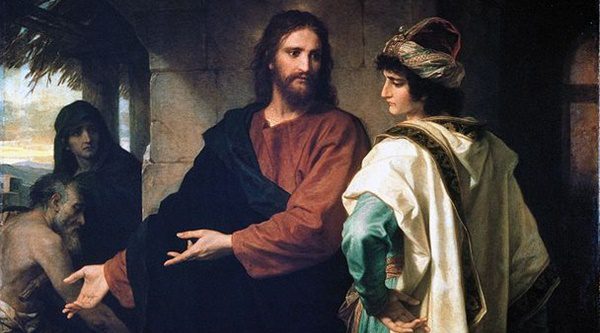
Jesus, on the other hand, wanted to empty ritual and worship of all violence and show the nonviolent face of God.
-Rev. Tom Truby
Pastors have a frequent question when they begin to discover mimetic theory. “That’s great. But how does it preach?”
Reverend Tom Truby shows that mimetic theory is a powerful tool that enables pastors to preach the Gospel in a way that is meaningful and refreshing to the modern world. Each week, Teaching Nonviolent Atonement will highlight his sermons as examples of preaching the Gospel through mimetic theory.
Lent 2-2018
February 25, 2018
By Thomas L. Truby
Mark 8:31-38
Jesus Teaches His Disciples Something Totally New
This is Lent 2 and each Sunday we are moving closer to how the most revealing story in history ends. Jesus is preparing his disciples for what he knows is coming. “Then he began to teach them that the Son of Man must undergo great suffering, and be rejected by the elders, the chief priests, and the scribes, and be killed, and after three days rise again.” This one sentence will be behind the bulk of what I hope to communicate today.
Here it is late in Jesus’ ministry and he begins to teach them something totally new, totally outside their frame of reference and totally unexpected. He had been showing them this all along but now he puts it into words so that someday they too can talk about it.
He tells them that he must undergo great suffering, be killed and in three days he would rise again. They thought they had been following a revolutionary leader, a charismatic general, a fierce and focused fighter who would defeat their Roman enemies and clear out the corrupted leaders in Jerusalem who collaborated with them. (In fact I still think he is a revolutionary leader but not in any way they can imagine. He is more revolutionary than any revolutionary had ever been.) But they are stuck on how he can undergo great suffering and then die and still remain helpful to them? This makes no sense to them. To me, it shows they were caught up in the same problem Jesus came to resolve.
While Jesus had healed the sick, thrown out demons, taught them to include the stranger and showed compassion beyond their own, he had never said he would be killed. How could that be part of the plan? And yet Jesus says this whole sequence is a “must,” not an option.
Peter took Jesus aside and quietly told him that he had to be wrong. You can’t lead a revolution this way. The successful revolutionary takes over the reins of power and calls the shots thereafter. We are behind you Jesus, you can do this.
It’s the personal intensity and depth of relationship Jesus exhibits that gets me here. This is not an interdepartmental memorandum. “Turning and looking at his disciples, he rebuked Peter and said, ‘Get behind me, Satan! For you are setting your mind not on divine things but on human things.’”
There is a difference between how human thinking that has been formed by how other humans think and how the creator of humans thinks. Each of us has to decide which line we will choose. Winning at all costs and having power over other humans is an all too human thing that doesn’t work very well. It doesn’t deepen relationships, advance human freedom or bring an environment of peace and serenity. Everyone wants to ensure they win and somebody else is blamed for the discord their rivalry generates. Even Jesus is tempted to do this. Jesus says to Peter, “Peter, you are tempting me to be like everyone else. But if I do I can’t model for you the way through this predicament that has always trapped the human species.
Successful leaders who think like the world don’t undergo great suffering. They impose great suffering on others if they can pull it off. This is why the disciples find Jesus so hard to understand. They didn’t get the memo that John the Baptist and Jesus were on very different pages when Jesus was baptized. John thought Jesus was signing up for a holy war against all sinners who didn’t believe as John did and he was very happy about Jesus’ baptism because he saw Jesus as the even greater leader who was coming after him to finish the job. Jesus, on the other hand, wanted to empty ritual and worship of all violence and show the nonviolent face of God. To do that, he would inevitably challenge the elders, the chief priests, and the scribes by showing them redundant, unnecessary, a cover up of the truth and hypocrites to the core.
When these corrupt leaders saw what Jesus was doing, and realized he would subvert their authority because people would no longer believe God was wrathful and needed appeasement, they had to take action. This is why the Son of Man must undergo great suffering, and be rejected by the elders, the chief priests, and the scribes, and be killed. Jesus is threatening to undermine their world by revealing their jobs as unnecessary, their power and prestige as false, and their privileged life style as bogus—the very things revolutionaries do.
Jesus knew this would happen. Way back in the beginning when Jesus was baptized into John’s movement Jesus knew he would subvert it by how he lived and what he taught. That was the plan from the beginning. He would reveal the nonviolent God who loves all his creation even though it costs him his life.
But how do you reveal this nonviolently? When institutions and individuals that don’t give life but take it are revealed they will react by crushing the revealer. Being nonviolent you let them crush you and as they do so, you forgive them. That’s what Jesus did. To forgive is to respond nonviolently so their violence is all the more apparent. And Jesus can give his life knowing that in three days God will raise him from the dead.
Jesus’ God who is a lover is not going to allow his son’s life to be blotted out, certainly not by some selfish power mongers who will do anything to ensure they stay in power. They may kill him, revealing their commitment to violence – violence that old driver of human culture, but the God of life, compassion and relationship is not going to be controlled by that. He is going to forgive the culprits and raise their victims, including Jesus, his Son, back to life.
So what is the nonviolent way for revealing and defeating the power of violence? It is forgiveness; a forgiveness that Jesus demonstrates by using it to forgive those who were in the process of killing him.
Forgiveness always takes the wind out of evil’s sails. Forgiveness limits the damage evil can do and breaks the Satan’s hold on his victims. Forgiveness removes fear and restores life. Jesus called the crowd with his disciples, and said to them, ‘If any want to become my followers, let them deny themselves and take up their cross and follow me.” To follow Jesus is to forgive. If we want to save our life, making sure that our losses are avenged, we will only lose our life. But if we lose our life in imitation of Jesus and for the sake of the gospel, we will save our life.
Real life can only be found in forgiveness. Even if we were to gain the whole world in our quest to even the score, there would be no profit to us.
Sometimes I think we are ashamed of forgiving. We think it weak and the militancy of revenge superior. If that’s the position we take, we show that we are ashamed of Jesus and his words in this adulterous and sinful generation where there is a lot of forgiveness needed to just live with a modicum of serenity. Jesus says if we are ashamed of living out his forgiveness, the Son of Man will also be ashamed of us when he comes in the glory of his Father with the holy angels. He may be ashamed of us for settling for less in our commitment to a grudge but he will forgive us, for that is who God is. The God Jesus revealed always forgives. Amen.
Stay in the loop! Like Teaching Nonviolent Atonement on Facebook!















